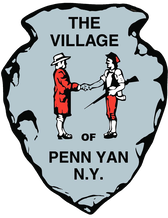|
The Village of Penn Yan was awarded a $10 million dollar Downtown Revitalization Initiative (DRI) grant in 2018. New York State's DRI provides support for the development of vibrant downtown neighborhoods. During the following years, Penn Yan's downtown area and parks will go through some exciting changes.
Located on the north end of beautiful Keuka Lake, the Village and surrounding area provide recreational opportunities and lodging all year long for all ages. Enjoy swimming, boating and ice fishing or visit area shops, restaurants and craft beverage manufacturers in our relaxed, quiet community. Penn Yan started off as two separate settlements, in 1823. The Village of Penn Yan incorporated in 1833. |
|
The big event that shaped the village was the opening in 1833 of the Crooked Lake Canal. Main Street crossed it north of the mills; the unsold property in Penn Yan was acquired by a syndicate of local businessmen who proceeded to develop a commercial and industrial enterprise. It was focused on the sudden opening of markets east toward Albany and New York, and west to Buffalo and the plains beyond via access to Seneca Lake and the epochal Erie Canal.
For the remainder of the 19th century Penn Yan was relatively much larger and more open to the great movements of the day than it would remain. Abolition, temperance, women’s rights rolled through like the cars of a booming train; nationally-known speakers convened audiences in the several large speaking-halls and opera houses. Even after the Canal and railroads died, Penn Yan served warehouses, ice houses, brokerages and more; besides fresh fruit and huge bales of wool, products like baskets, paper, bulk grocery bins, wheels and spokes, wheat and malted grain poured out in a golden stream.
Now standing on the exciting edge of a broadened view, with rediscovery of the things that were always here, Penn Yan is grounded in its past and looking to the future.
For the remainder of the 19th century Penn Yan was relatively much larger and more open to the great movements of the day than it would remain. Abolition, temperance, women’s rights rolled through like the cars of a booming train; nationally-known speakers convened audiences in the several large speaking-halls and opera houses. Even after the Canal and railroads died, Penn Yan served warehouses, ice houses, brokerages and more; besides fresh fruit and huge bales of wool, products like baskets, paper, bulk grocery bins, wheels and spokes, wheat and malted grain poured out in a golden stream.
Now standing on the exciting edge of a broadened view, with rediscovery of the things that were always here, Penn Yan is grounded in its past and looking to the future.
